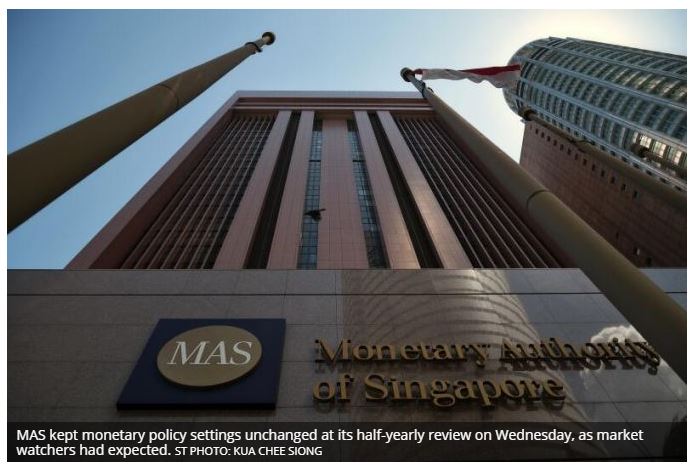Monetary Authority of Singapore stands pat on Singdollar policy at October meeting
SINGAPORE’S central bank kept monetary policy settings unchanged at its half-yearly review on Wednesday, as market watchers had expected.
The neutral position, taken after two straight rounds of easing, came as the economy is tipped to recover in 2021, but with weak underlying momentum.
Amid the global economic downturn of the Covid-19 pandemic, the Monetary Authority of Singapore (MAS) made no change to the width of the band in which the Singapore dollar nominal effective exchange rate (SGDNEER) is allowed to float.
The MAS, which lowered the mid-point of the band and cut its rate of appreciation to zero in end-March, also left both centre and slope untouched this time.
“As core inflation is expected to stay low, MAS assesses that an accommodative policy stance will remain appropriate for some time,” the MAS said in its October policy statement.
“This will complement fiscal policy efforts to mitigate the economic impact of Covid-19 and ensure price stability over the medium term.”
The forecast for both headline inflation and core inflation was narrowed to between -0.5 per cent and zero for the full year, from a forecast range of -1 per cent to zero before.
Core inflation excludes the costs of accommodation, which are expected to fall on a decline in foreign employment, and private road transport, which the MAS expects will “rise modestly” on tighter Certificate of Entitlement supply.
The central bank added in its statement that external inflation will likely be low in the coming quarters, on the back of weak demand, while domestic cost pressures will also “stay subdued” as labour market softness weighs down wage growth.
“Nevertheless, the disinflationary effects of government subsidies introduced this year will fade, while demand for some domestic services would also gradually pick up,” it said.
The MAS expects core inflation to return to mildly positive levels in 2021 – between zero and 1 per cent – “but remain well below its long-term average”. Meanwhile, headline or all-items inflation is tipped to fall between -0.5 per cent and 0.5 per cent for the same period.
The latest central bank decision came as the Singapore economy shrank by 7 per cent year on year in the third quarter, according to estimates from the Ministry of Trade and Industry, which forecasts a decline of between 5 per cent and 7 per cent for the full year.
Selena Ling, head of treasury research and strategy at OCBC, said of the monetary policy statement: “Overall, the tone is basically status quo with a tinge of dovishness out into 2021, when a clearer assessment of the global and domestic economic recovery prospects and inflationary outlook may warrant a reconsideration of the currently accommodative monetary policy stance.”
Weighing on inflation, analysts Brian Tan, Ashish Agrawal and Gu Yile from Barclays noted: “Despite its projection of a pick-up in 2021 GDP, the MAS does not appear to expect the negative output gap to close completely next year.”
Similarly, Maybank Kim Eng economists Chua Hak Bin and Lee Ju Ye highlighted the MAS’ mention of “the economic scarring inflicted by the deep global recession” as a drag on external demand for the year ahead.
“The MAS sounded cautious on its outlook for the recovery, stating that the sequential growth in Q4 will likely slow,” they said in their flash note.
Separately, Citi analysts had affirmed just the day before that they expected the MAS to stay on hold with monetary policy, as strong Singapore dollar inflows in recent weeks were deemed “reflective of no meaningful dovish expectations”.
“Together with risk of potential shifts in US elections polls, disappointment on stimulus and/or vaccine timelines, risk-reward seems to be for favouring cautious SGD (singapore dollar) exposure, in our view,” the Citi analysts added in a Tuesday note.
“Having said that, we are mindful that in spite of dovish action at the October 2019 policy review, SGD was quick to resume its outperformance.”
Similarly, Standard Chartered economist Jonathan Koh said: “In case of a surprise re-centring lower of the policy band in October, we expect USD-SGD to trade (around) 1.5 per cent higher in response. In comparison, if the MAS leaves monetary policy unchanged, in line with our expectations, we expect very limited market reaction.”
Source: https://www.businesstimes.com.sg/government-economy/monetary-authority-of-singapore-stands-pat-on-singdollar-policy-at-october


 English
English




